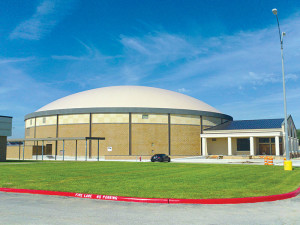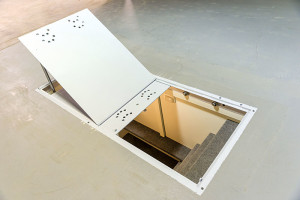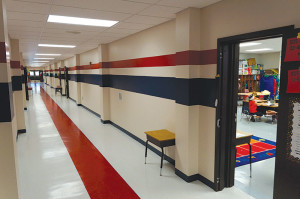Since the industry’s birth in the 1970s, storm shelter protection has risen from dank, dark, underground storm cellars found in backyards to above ground shelters fully integrated into residential or commercial construction. To enforce the proper design of these storm shelters, the ICC 500: ICC/NSSA Standard for the Design and Construction of Storm Shelters was developed. This article focuses on the structural provisions of the 2014 edition of ICC 500, how the provisions differ from typical structural design, the NSSA’s role in the development of the ICC 500, and new storm shelter trends.

Large community shelter.
Historical Perspective
In 2001, the leading professional engineers involved in extreme wind resistant design founded the National Storm Shelter Association (NSSA) and developed the first industry standard to provide guidance for the design, construction, and performance of storm shelters. By establishing design wind speeds, debris impact resistance, and occupancy safety requirements, engineers and architects now had a document on which to rely for sound storm shelter design. The NSSA standard became the foundation document for the ICC/NSSA Standard. First published in 2008, this standard was developed by the ICC/NSSA Consensus Committee on Storm Shelters (IS-STM) that operates under the ANSI-approved ICC Consensus Procedures for the Development of ICC Standards with public meetings and organizations from across the country participating. By co-publishing the ICC/NSSA Standard and a commentary in development, the NSSA, in partnership with the ICC, continues its leadership position in the storm shelter industry.
The design industry has recognized the importance of occupancy life safety in high wind events by making shelters a mandatory component of certain building types constructed in storm prone areas. The 2015 edition of the International Building Code (IBC), in Section 423, requires construction of storm shelters in certain Group E, Educational Facilities, and in critical facilities such as 911 call stations, emergency operation centers, fire, rescue, ambulance and police stations in higher wind areas. These shelter designs must meet the ICC/NSSA Standard.

Below the garage slab shelter.
Storm Shelter Performance Requirements
Design wind loads and performance requirements for storm shelters far exceed normal building code requirements. Different failure modes and loadings must be considered since the majority of adjacent non-shelter structures will be destroyed or damaged during an extreme wind event. These include envelope perforation due to windborne debris, collapse of adjacent taller structures onto the shelter, laydown of nearby objects such as trees, signs, or towers that could impact the shelter, and rollover of vehicles or small buildings impacting the shelter. Some failure modes (sliding, overturning, uplift, foundation connection failure, etc.) are similar to those encountered in other structural design. But with much higher wind load demands, design solutions can be harder to achieve and ensuring a continuous load path from all shelter components to the supporting foundation is paramount.
Storm shelters are required to be designed with the assumption that surrounding or host buildings are completely destroyed, leaving the shelter fully exposed to the wind forces of a storm. If components such as stud framing and roof trusses of the host building are attached to the shelter’s structure, the loads imparted from these elements must be accounted for in the shelter’s design. The 2014 edition of the ICC 500 provides a rational procedure for determining the maximum force that a connected host building element can transmit to a storm shelter.
Design Wind Speeds
Design wind speeds found in ICC 500 are based on records of measured wind speeds in hurricanes and estimated wind speeds for tornadoes based on a 10,000 year Mean Recurrence Interval (MRE – the inverse of the probability that the event will be exceeded in any one year). Contour maps are presented in ICC 500 for both tornadoes and hurricanes for the continental U. S. and its territories. For site-built storm shelters, design wind speeds may be determined using these maps. For factory-built, or relocatable storm shelter structures that may be installed in any location, the ‘worst case’ design wind speed should be used. These design wind speeds are as high as 250 miles per hour for tornado shelters and 235 miles per hour for hurricane shelters. These elevated speeds can result in wind pressures that are nearly five times as great as the wind pressures typically required for the design of buildings.
Wind-Induced Pressures
Wind pressures for storm shelters are calculated using ASCE 7-10, Minimum Design Loads for Buildings and Other Structures. Due to the unique nature of extreme wind event loadings, ICC 500 specifies the variables required to calculate the Main Wind Force Resisting System (MWFRS) and Components and Cladding (C & C) loadings. Values are specified for the directionality factor, exposure category, and topographic factor and guidance is given on selecting the proper internal pressure coefficient, GCpi.
Wind-induced internal pressures from winds acting through openings are added to external pressures. Internal pressures have a large effect on the forces acting on the shelter’s structure and its connections to the foundation. Atmospheric pressure change due to the reduced pressure in the vortex of a tornado can also result in internal negative and external positive, or ballooning, pressures. While significant in tornadoes, atmospheric pressure change is not a large factor in hurricanes where winds are more straight-line in behavior (due to the storms diameter) and somewhat cyclic in nature.
The internal pressure coefficient, GCpi, accounts for these pressure induced positive and negative load changes. The value of this coefficient varies with the ratio of openings to shelter volume or the degree of enclosure as defined by ASCE 7, i.e., whether the building is considered enclosed or partially enclosed. Small residential shelters are usually designed as enclosed spaces. Community shelters are typically defined as partially enclosed buildings due to the ICC 500 requirement for the largest operable opening on a windward side of the shelter to be considered open during peak wind speed of the storm.

School corridor shelter retrofit.
Testing for Pressure and Debris Impact Resistance
The mature field of structural engineering enables analytical approaches to be applied to the wind-induced pressure analysis and design for most storm shelters and their components. When analytical analysis for wind pressure is not practical, ICC 500 gives requirements and procedures for laboratory pressure testing of walls and roof assemblies, door assemblies, glazing, and impact-protective systems.
Debris impacting the shelter is a major design issue that engineers must consider. Although a substantial science base has been developed for terminal ballistics, such as bullets striking armor plate, much less is known about the impacts of a large variety of wind-borne debris missiles, such as wind-driven lumber or roof decking striking shelter surfaces, doors, vents, glazing, and impact-protective systems. Therefore, to ensure occupant protection, ICC 500 requires laboratory impact testing of the storm shelter structures and all impact-protective systems.
Extensive and specific requirements are in ICC 500 regarding numbers and locations of debris impact tests that must be performed on storm shelter components to ascertain their suitable performance. For example, a storm shelter door must be impacted in at least three locations – in a central location, within 6 inches of a corner, and within 6 inches of the main latch. Similar specificity is given for other components. Systems (such as a door system consisting of a door, frame, hardware, and fasteners) must be tested in a configuration as similar as possible to the intended shelter configuration. It is not sufficient to test the components separately to predict performance of the assembled system.
Third Party Review, Quality Assurance, Special Inspections, and Structural Observations
The design, construction, and installation of storm shelters are all critical to their performance. ICC 500 requires safeguard checks to ensure quality in each of these phases. Peer-reviews or independent third-party evaluations are required for community shelters with 50 or more occupants, daycare shelters with 16 or more occupants, school shelters, and shelters in Risk Category IV as defined by the IBC. A Quality Assurance Plan covering quality control issues must be part of design drawings and specifications which are sealed by a design professional, and the contractor must submit a written statement of responsibility acknowledging these special requirements to the authority having jurisdiction, the design professional, and the owner prior to commencing work.
During construction, special inspections are required, many of which are similar to those required by the IBC, with some special inspections added such as on-site inspections to verify the locations and installation of post-installed anchors in hardened concrete or masonry and verification of the structural adequacy of existing foundations used for shelter support. Community shelter construction also requires structural observations to be performed by a registered design professional during significant phases of construction.
Other Life Safety Considerations
Only the structural provisions of the ICC 500 have been covered in this article. The Standard also gives requirements on other life safety issues in shelter design, such as shelter siting, occupancy density, egress, mechanical and natural ventilation, lighting, fire safety, sanitation facilities, locks and latching, and signage, among others.
NSSA’s Role in ICC 500 and the Shelter Industry
The National Storm Shelter Association has played a major role in the development and promotion of quality storm shelter design, manufacturing, and construction since its inception. The primary purpose of the association is to ensure the highest quality of manufactured and site-constructed storm shelters for protecting people from injury or loss of life due to tornadoes, hurricanes and other extreme windstorms. The ICC/NSSA Standard has significantly contributed to the stability and orderly progress of development of the storm shelter industry. NSSA continues to play an important role in development of the ICC/NSSA Standard by being represented on the ICC/NSSA Consensus Committee on Storm Shelters (IS-STM). NSSA members are participating in development of the ICC 500 Commentary, whose development cost is also sponsored by the NSSA.
New Storm Shelter Trends
Under the guidance of the ICC/NSSA Standard, a remarkable variety of storm shelters has emerged. Shelters range from above ground or underground residential, which offer space for as few as three occupants to large community shelters housing thousands of occupants and serving multiple purposes such as school corridors, gymnasiums, or auditoriums. Solutions have also been developed to effectively retrofit existing buildings with ICC compliant shelters. The wide variety of storm shelters is a testament to the free enterprise system of the U.S., and the creativity and entrepreneurship of storm shelter and shelter component designers, builders, and manufacturers.
Participation in NSSA by structural engineers offers a challenging and exciting professional involvement. Since its founding in 2001, NSSA has grown from twenty Producer Members to over sixty members of various membership categories (Producer, Installer, Professional, Associate, Media Partner). Technical information and continuing education are available at NSSA seminars, annual association meetings, and via webinars. For more information on membership opportunities, visit www.nssa.cc.▪
The ICC 500-2014: ICC/NSSA Standard for the Design and Construction of Storm Shelters is available for adoption and use by any jurisdiction. To learn more about the standard, visit www.iccsafe.org.
